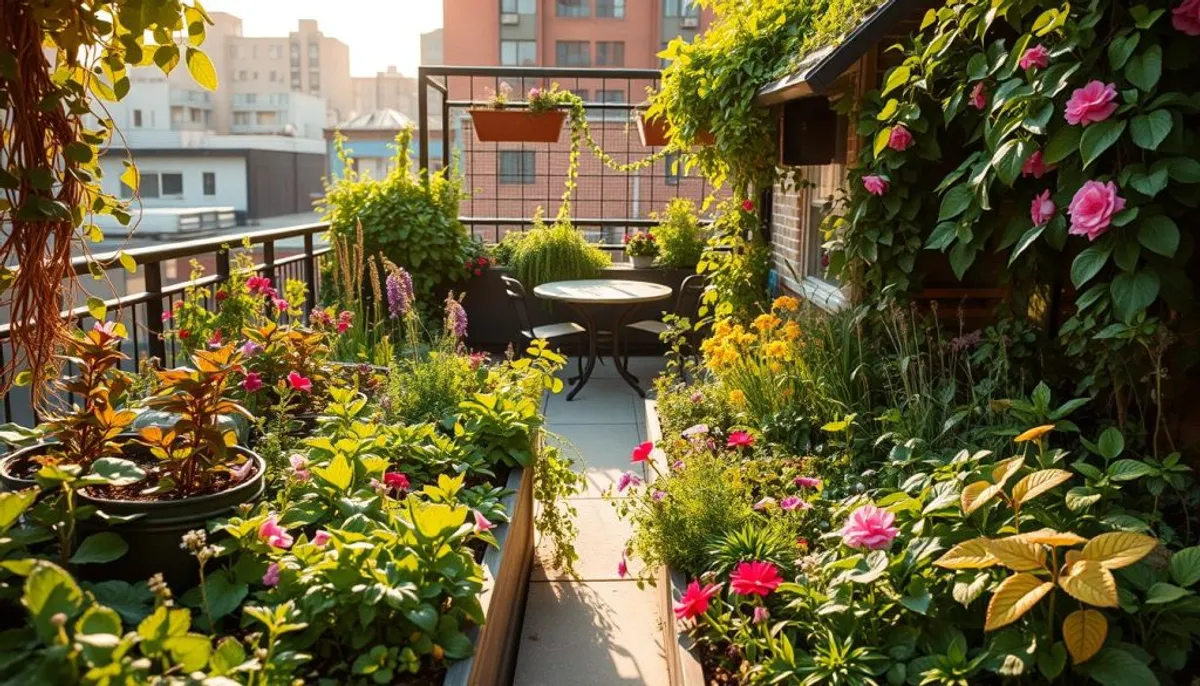The urban gardening is experiencing remarkable growth. More and more city dwellers are looking to grow their own vegetables, even on a small balcony. This trend of the balcony garden or in reduced spaces draws inspiration from 19th-century techniques, adapted to modern challenges.
Did you know that a small growing area can be very productive? For example, a market garden of 1000 m² could generate up to €50,000 in revenue according to some estimates. Although these figures are theoretical, they demonstrate the potential of small-scale cultivation.

Whether you have a balcony, a terrace, or a small garden, this guide will help you optimize your space to grow your own vegetables. We will see how to choose the right varieties, plan your crops, and maximize your yields, even on 30 m². Ready to embark on the adventure of urban gardening?
The fundamentals of small-scale market gardening
Small-scale market gardening has gained popularity, notably thanks to figures like Jean-Martin Fortier. His book, “The Market Gardener,” has been a catalyst, reaching 150,000 copies sold. This underscores the growing importance of biointensive agriculture.
History and evolution of intensive crops
Intensive cultivation methods have a deep history. In the 19th century, Parisian market gardeners cultivated on only 6% of the area of Paris intra-muros. This efficiency has been confirmed by experts like Fortier, who now operate organic micro-farms on areas of one hectare.
Basic principles of bio-intensive cultivation
Bio-intensive cultivation is based on several fundamental principles:
- Crop rotation every three years
- Use of permanent beds
- Diversification of crops to limit risks
- Composting and ecological soil management
Advantages and challenges of gardening in reduced spaces
Gardening in reduced spaces offers many advantages, such as high productivity and sustainable resource management. Permaculture and organic farming are preferred approaches. However, there are challenges, particularly in terms of labor and optimal space management. Techniques like container gardening and drip irrigation help overcome these obstacles, making small-scale cultivation accessible to all.
What to grow in small spaces: optimal techniques
Small-scale market gardening requires precise strategies to increase production. History reveals that this practice is deeply rooted in time. In the 19th century, up to 6% of the area of Paris intra-muros was dedicated to market gardeners' gardens. These gardens, averaging 4,000 to 8,000 m², demonstrate the efficiency of intensive cultivation.

Organization of growing beds
The organization of the beds plays a crucial role. Jean Martin Fortier, a renowned market gardener, adopts beds that are 120 cm wide and 30 m long. The aisles measure 45 cm, optimizing space for growing potted vegetables and dwarf fruits.
Management of rotations
Crop rotation is fundamental for soil health. Market gardeners in Île-de-France used to perform up to 8 annual harvests on the same plot. Today, dividing the space into distinct zones is recommended. This approach includes herbs in the crop cycle.
Optimization of available space
Every centimeter is valuable in a limited space. Modern methods allow for effective cultivation on reduced surfaces. Sylvain Couderc, for example, cultivates on 4,000 m², including 300 m² of greenhouse. He employs plots that are 120 cm wide and 30 m long, with aisles of 45 cm, optimizing space for his potted vegetables and dwarf fruits.
The use of vertical crops and polyculture are effective strategies to maximize yields in small spaces. These methods allow for the cultivation of a variety of potted vegetables and herbs, even in the most restricted spaces.
Essential layout and equipment
To succeed in your balcony garden or vertical garden, it is crucial to choose your structures and tools wisely. Thoughtful layout maximizes the available space and optimizes your harvests.
Suitable growing structures
Greenhouses are ideal for intensive crops. Choose models that are 9 to 10 meters wide for a stable climate. Caterpillar tunnels, more affordable and mobile, are perfect for beginners in small-scale market gardening. For those wishing to benefit from financial support, it is possible to use an adage pass culture account.
Effective irrigation systems
Irrigation is crucial for your balcony garden. Install a rainwater reservoir at each gutter to maximize collection. This method reduces costs and avoids thermal shocks during heatwaves. Adapt watering to the specific needs of your plants.
Essential tools
Equip yourself with the right tools for your vertical garden:
- The grelinette, an essential tool
- The 75 cm market gardener rake, perfect for small spaces
- The Jang seeder, ideal for optimal precision
- The wheeled hoe with a 30 cm blade
For a couple, 100 m² of vegetable surface is sufficient. Double this surface for a family of four. Sow your short-cycle vegetables frequently: salads every 3 weeks, radishes every 15 days. This method reduces waste and ensures continuous harvests while promoting cultural accessibility.
Planning and management of crops
Success in urban gardening and organic farming on small surfaces depends on meticulous planning. This crucial step can take 2 to 4 days. It includes organizing the garden, the crop plan, and production forecasts.
Adapted cultural calendar
A well-designed calendar is fundamental to optimize production. It must take into account local specifics to maximize space utilization throughout the year. For example, in temperate climates, good drainage is crucial for an early start to the growing season.
Choosing varieties suitable for small spaces
The selection of compact and productive plants is essential for urban gardening. Dwarf or climbing varieties allow for effective use of vertical space. The association of crops, such as “the three sisters” (corn, squash, and beans), can increase total yield by 20%.
Crop succession strategies
Smart crop rotation is crucial for organic farming. It maintains soil fertility and reduces pest problems. Polyculture can decrease diseases by 60% in a diverse vegetable garden.
| Crop | Yield per bed | Potential income |
|---|---|---|
| Salads | 300 units | €250 |
| Cocktail tomatoes | 530 kg | €1500 |
| Eggplants | 450 kg | €1700 |
By adopting these practices, urban gardening can require up to 50% less energy, water, and time. It offers impressive yields even on small surfaces.

Sustainable intensive cultivation techniques
Small-scale cultivation requires specific methods to optimize production while preserving the environment. Permaculture offers innovative solutions for optimizing small-scale cultivation. It guides towards sustainable practices.
Natural fertilization methods
Composting is crucial for maintaining soil fertility without chemical fertilizers. Use organic waste from your garden and kitchen to create rich compost. Green manures, like mustard, naturally enrich the soil. Additionally, incorporating memory games for seniors can also stimulate the mind and promote better task management in the garden.
Soil and compost management
Soil health is essential in permaculture. Avoid deep plowing that disrupts soil structure. Opt for permanent mulching to protect the soil and promote its biodiversity. The ancestral customs of surface composting directly nourish beneficial microorganisms.
Crop protection in reduced spaces
In a small space, prevention is paramount. Promote biodiversity by associating companion crops. For example, marigolds repel tomato pests. Use insect nets without pesticides. Drip irrigation limits excessive moisture and reduces the risk of fungal diseases.
These techniques, inspired by permaculture, are adapted to small-scale cultivation. They allow for intensive production while respecting the natural balance of the garden. They are part of a sustainable approach, essential for the future of our urban and peri-urban agriculture.
Conclusion
Small-scale market gardening represents an exciting adventure for adventurous gardeners. By adopting container gardening techniques and selecting varieties of dwarf fruits, it is possible to optimize the available space. A micro-farm of 1000 m² can thus produce up to 8000 kg of vegetables per season, thanks to careful planning.
The success of this activity relies on several essential factors. Effective weed management, which occupies 50% of the time, is crucial. Direct sales, favored by 60% of micro-farms, maximize profits. Additionally, practices such as minimal tillage can increase fertility by 30% in just 3 years.
Despite the challenges, areas of 3000 to 5000 m² per person seem more achievable. The key lies in adapting techniques to each unique situation. With patience and adaptability, small-scale market gardening transforms into a rewarding and fruitful adventure.
RelatedRelated articles


